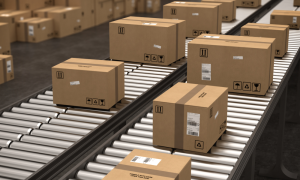A crucial component of any business, big or small, is inventory control. It guarantees that you don’t overstock and waste precious resources by not having too much inventory on hand to fulfil demand. One of the key tools used in inventory control is barcodes. These simple yet powerful codes help businesses keep track of their inventory by assigning a unique identifier to each product. But how exactly are barcodes used for inventory control? In this article, we’ll dive into the world of barcodes and explore how they can help you take control of your inventory management.
What Is Barcode Technology in Inventory Control?
Barcode inventory technology is an inventory system that uses barcodes to identify and track inventory. It’s a common practice in many industries, including retail and manufacturing. Barcode scanners read the barcode on an item and then use this information to retrieve details about the product from a database. This allows you to keep track of your inventory without having to manually enter each individual item into your system.
There are three main types of barcodes:
- UPC (Universal Product Code)
- EAN (European Article Number)
- QR codes (Quick Response).
The first two, barcodes online and barcodes reader, are used primarily in North America, while QR codes (barcodes qr codes) are more popular internationally due to their ability to hold more information than other types of barcodes can handle at once–upwards of several thousand characters per image!
Why Should a Business Use Barcodes for Inventory Control?
Every business needs inventory control technology that can effectively track and trace inventory while also being user-friendly, cost-effective, and delivering desired outcomes.
This potential is reflected in barcode technology. Let’s understand what factors make it so important for businesses to use it.
Accurate tracking of stock:
Barcodes can be scanned to identify the product and its location in the warehouse, allowing you to keep track of how much stock you have on hand at all times. This helps ensure that you don’t run out or overstock any items before they’re sold, which improves efficiency and reduces costs.
Improve Efficiency:
Barcode inventory control provides improved efficiency due to reduced manual data entry errors when using barcode scanners instead of manual data entry systems such as paper forms or spreadsheets that require employees input information into computers manually (which often results in inaccurate data).
Easy Implementation:
Barcode technology, barcodes check, involves one of the easiest and most clean implementation setups. They are easy to use, and data can be obtained by scanning using a mobile scanner. This easy Implementation factor makes it a perfect choice for small business industries.
High Accuracy:
The level of data accuracy that this technology can generate is far higher than humans. The risk of error is comparatively low in the case of the barcode. Manual data entry is a tedious task, so there is a high chance a human employee can make an error. Data entry operators make errors more frequently than barcodes. On average, they make a mistake every 300 keystrokes. Meanwhile, even the simplest barcode only has an error rate of 1 in every 394,000 scans.
Cost Effective:
Barcode technology automates the entire process of inventory control with little to no human interference. The businesses can receive real-time updates related to the product, saving time and labor costs. Since the information has a high accuracy rate, the company can manage its inventory without taking any unnecessary risks or paying for extra storage space or overstock.
Improve Data Management:
The barcode inventory control includes an entire system of software databases that can record a huge amount of data. This data is hard and hectic to operate manually and prone to mistakes. In order to manage the gigantic list of product information, the barcode inventory control system is very effective, wherein all the product-related information is stored in the barcode, which is further stored in a centralized database. Barcode scanners can quickly and accurately read the barcode information, which is then transmitted to a powerful software like OneSETU system for real-time data collection and analytics.
How Are Barcodes Used for Inventory Control?
When a business decides to implement barcodes in its inventory management system, they need to check and standardize many things. Understand your present inventory control system and identify the lacuna. Plan with your team if implementing barcode technology can actually cater to your issues. To determine if barcodes are the right solution for your business, it’s important to comprehend how they are utilized for inventory management. This understanding will help you evaluate if barcodes offer the scalability and effectiveness required for your business.
Identification and Tracking:
A barcode is attached to each product with a unique identification. This helps the software keep a product identification report and exact tracking location. In inventory control, barcodes can provide a tracking accuracy rate of 99%, which will positively impact product management. You can use the software called OneSETU to generate marks and scan digital twins of finished goods, which can be easily identified by barcode technology. This allows for quick and efficient data collection throughout the supply chain, from suppliers to consumers.

Track the expiration dates of products:
Barcodes can also be used to track the expiration dates of products, which is particularly important in industries like healthcare and food service, where expired products can have serious consequences. By scanning barcodes, employees can quickly identify products that are approaching their expiration date and remove them from inventory before they become a liability.
Reordering:
Barcodes are also used to check and implement the “reorder point.” This technology is used by businesses to automate the triggering of product reordering. Barcode qr code generator can be used to automatically generate a purchase order to record the product if you have set a record point. As barcodes have all the data about your present stocks, this task is a cakewalk for it.
Data Analysis:
Barcodes can retain product information. Almost all the important decisions of a business are dependent upon data. Everything needs proper analysis, from the inventory production to their selling rate. A huge amount of data from a business can be easily managed and processed using this technology. This is why barcodes are also used for data analysis of a business.

FAQs: Inventory Control
Is barcode technology easy to implement?
Yes, Barcode technology is simple to implement because the software can generate unique barcodes for each product, which can be easily printed and affixed to the respective items.
Can barcode technology be used for all types of inventory functions?
Yes, Barcode technology can be utilized for an array of inventory-related activities, such as tracking finished products or reselling items, irrespective of the size or type of business.
What is barcode technology in inventory control?
In inventory control, barcode technology is employed as a system to store and track product information, which can be retrieved upon scanning the barcode using a scanner.
How does barcode technology ensure high accuracy in inventory control?
Barcode technology automates manual stock control processes, improving efficiency and accuracy. Each inventory item is assigned a unique barcode and scanned with a barcode scanner as it moves through the warehouse.
What is the main benefit of using barcodes for inventory control?
Using barcodes to identify and track products can significantly improve the accuracy rate at which items are tracked, with a potential increase of up to 99%.
Conclusion
Barcodes are an essential tool for inventory control in a wide range of industries. They provide a quick and efficient way to track inventory levels, identify products, and ensure that pricing and order fulfillment are accurate. By leveraging barcode technology, businesses can streamline their inventory management processes.
The barcode technology needs to be combined with software like OneSETU for proper data management. This combination ensures traceability and accuracy of product movements, locations, and more, which can help businesses make better decisions and improve efficiency. Check out Qodenext today to take the first step to automate your business.
Get in touch with us now to help you make the best choice to manage your fleet!


